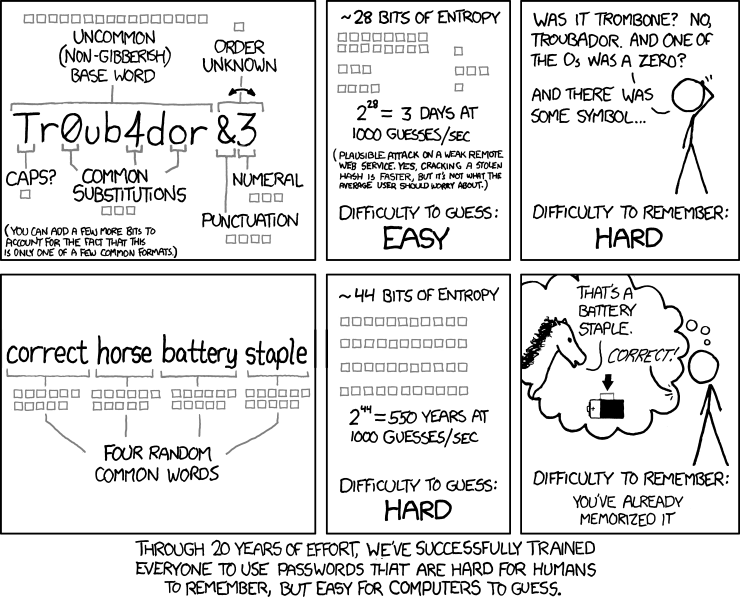| title | author | date | lang |
|---|---|---|---|
Introduction to Linux security |
CSC Training |
2020-04 |
en |
- some definition on security
- some guidlines on what to do to keep your own system save
- Information security is the practice of preventing unauthorized access, use, disclosure, disruption, modification, inspection, recording or destruction of information. (Wikipedia)
- Primary focus is the balanced
- protection of the confidentiality, integrity and availability of data
- while maintaining efficiency and productivity.
- The trinity explained:
- Confidentiality: don't let others access your data.
- Integrity: don't let others modify your data.
- Availability: make data available when it is needed.
| Computer crime | Rootkits |
| Vulnerability | Bootkits |
| Eavesdropping | Keyloggers |
| Malware | Screen scrapers |
| Spyware | Exploits |
| Ransomware | Backdoors |
| Trojans | Logic bombs |
| Payloads | |
| Worms | Denial of service |
- The single most common risk for you: loss of data.
- It's just a matter of a small typo in a command:
$ rm -rf . /*- DON´T EXECUTE THE LINE ABOVE: This will delete every file and directory on the system without asking anything (if you have permissions).
- Make backups – and keep them up-to-date!
- Do not run any unnecessary services, like www or email servers.
$ service --status-all- Enable firewall.
- Firewall is a process that monitors and controls incoming and outgoing network traffic.
$ sudo ufw enable && sudo ufw default deny incoming- Install patches regularly.
$ sudo apt update && sudo apt upgrade- or use desktop udate tool, instead
- Users can be managed from command line:
$ sudo useradd -m -G cdrom -c "Joe Cool" someone
$ sudo passwd someone- Most systems have an administrative
 graphical user interfaces for doing
that job.
graphical user interfaces for doing
that job. - Grant only permissions that are really needed, assign a password and make sure it's a good one.
- Do not use same password(s)
for different services.
- Use password managers, e.g. KeePassX.
- Pros: single master password to remember, cross-platform encrypted vault for all your passwords, great password generator, integration with browsers,...
- Cons: you can loose all your passwords in one go.
- Encryption is the process of encoding information in such a way that only authorised parties can access it.
- There are two common methods to encrypt your data:
- Filesystem stacked level encryption, where files and directories are encrypted individually with tools like eCryptfs and EncFS.
- Block device level encryption, where the whole block device (usually a disk) is encrypted using e.g. dm-crypt and LUKS
- Start with an empty directory
$ mkdir Private- Mount it using a special file-system type
ecryptfs
$ sudo mount -t ecryptfs Private Private- Enter a good passphrase and memorize it. There is no way getting your data back should you forget your passphrase.
- Without further ado just accept the default settings.
- Anything you save in the directory Private will now be encrypted.
- Unmount
$ sudo umount Private- SSH offers a secure remote login (and more) over unsecure
networks.
- Comes (almost) always by default with Linux and macOS. On a Windows computer a 3rd party client, e.g. PuTTY, is needed.
- It ensures that all communication to and from the remote server happens in an encrypted manner, and is based on something called ssh keys.
- Keys eliminate the need for passwords.
- You win twice: higher convenience and increased security!
- First you need to create a key pair (unless you already have one), which are used to encrypt and decrypt data:

$ ssh-keygen -t rsa -b 4096- This creates two files:
.ssh/id_rsaand.ssh/id_rsa.pubin your home directory. - The
id_rsais your private key. Do not disclose this one! - The
id_rsa.pubis your public key. You may think of it as a lock, which opens only with your private key. You may place it anywhere you want; it's public. - You may have as many key pairs as you wish. Use option
-f keynameto choose keypair name
- The public key needs to be copied over to a specific file,
~/.ssh/authorized_keys, on the remote host (server) you intend to log in with ssh:
$ scp ~/.ssh/id_rsa.pub [email protected]:
$ ssh [email protected]
host $ cat id_rsa.pub >> .ssh/authorized_keys- There is an elegant single-step command combining all this (next slide)
- The next time you log in to the remote host ssh will be using your keys instead of your password on that host.
- NB: If you assigned a passphrase for your keys (highly recommended!)
sshwill epeatedly ask for that passphrase. To avoid this, usessh-agent.
- Instead of manually copying the private key and including it into
.ssh/authorized_keyson the remote computer, we can use a command provided for exactly doing that
$ ssh-copy-id -i .ssh/id_rsa [email protected]- Give the name of the keypair without the
.pubsuffix; the command itself will take care that only the private key is transferred - You will be prompted the password of the remote computer (for the last time) to execute that comman
- Thereafter, you should be able to use the key to log in
